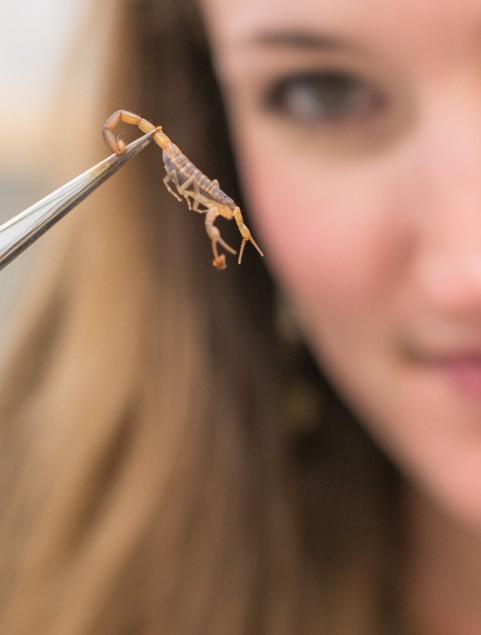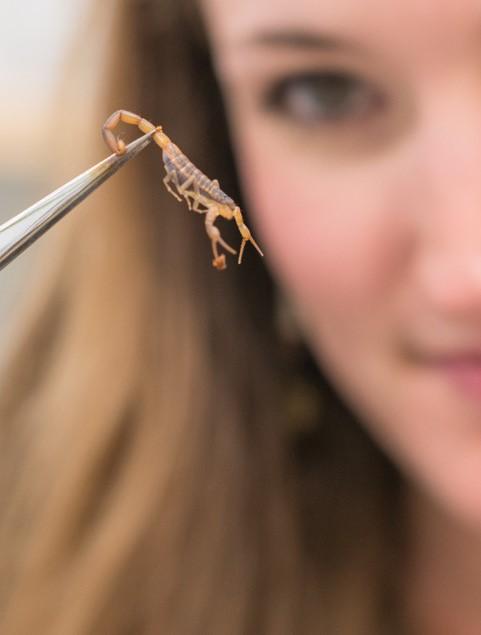
Credit: Micaiah Ward
TALLAHASSEE, Fla. — Scorpions can be found at every corner of the globe and on six of the seven continents, from the southern tip of South America to the arid expanse of the Sahara Desert.
That makes any rigorous accounting of the world's venomous scorpions — and their various effects on human beings — an extremely tall task. But in a new study published in the journal Toxicon, a team of Florida State University researchers proved they were up to the challenge.
In their report, the team documented 104 species spanning dozens of countries, providing a vital update to the global record of medically significant scorpions, or scorpions whose venom could be alternately gravely harmful or medically beneficial to human beings.
Their work helps modernize the study of scorpion epidemiology and reveals important gaps in the processes by which scorpions are collected, identified and characterized.
"There's a lot of hype about scorpions, about how they can kill you or send you to the emergency room," said FSU doctoral candidate Micaiah Ward, who led the study. "In some cases, that's absolutely true. But there are over 2,200 species of scorpion. Only about 30 of them might put you in the hospital, and of those, symptoms vary based on age and health."
Scorpions, like scores of other species, evolved venom as a tool for defense and predation. Often, scorpions' venom will develop in response to specific adaptations in their predators or prey, triggering a spiraling co-evolutionary process that produces more lethal venom in the scorpions and more robust resistances in their adversaries.
For this study, Ward and her colleagues conducted an exhaustive review of existing research in an effort to compile a comprehensive catalog of medically significant scorpions, their native locations and the severity of their symptoms. Their review shows that, while scorpions have propagated successfully throughout the globe, the most dangerous species appear in clustered hotspots.
"Most of the really harmful scorpions, the types that induce symptoms that could be fatal if not properly treated, are distributed throughout Asia, the Middle East, some in Africa, very few in the United States and quite a few in South America, particularly Brazil," Ward said.
A dangerous cocktail of tiny neurotoxic peptides gives some scorpion venom a decidedly unfriendly edge, but other scorpions produce venom that humans have learned to use to their advantage. One Iranian species produces a toxin that scientists suggest could be used to treat brain tumors, despite a name that sounds more malevolent than medicinal.
"It's common name is the deathstalker scorpion," Ward said "It produces a toxin that targets certain brain tumors to stop their growth. It's also called 'tumor paint' because they can use it to highlight a tumor before surgery so that they cut out all the parts of the tumor without leaving anything behind."
In addition to cataloging and mapping medically significant scorpions, the researchers' review also functioned as an investigation into the mechanisms of scorpion research itself. Their report revealed a number of disconnects between the many disciplines studying these species. Clinicians treating scorpion stings, Ward said, rarely communicate with scientists studying the properties of scorpions' venom or the nature of their habitats. The result was frequent discrepancies in the data.
"That was the biggest challenge," Ward said. "We were finding a bunch of reports for scorpions that were blown way out of proportion or that had the wrong species name. We tried to do our best with the updated phylogenies of different families of scorpions and where they are. It's not perfect, and it will change as we get more data."
How to go about collecting more reliable data? Ward said all citizen scientists can have a part to play.
"The first thing to do if you get stung by a scorpion is to stay calm," she said. "If you can, try to take a picture of the scorpion or put it in a cup and bring it to the emergency room with you. They can send it to a museum or somewhere where they can properly identify that species and associate it with the specific symptoms that you have. That's what we need."
###
This study was supported by the National Science Foundation.
Media Contact
Zack Boehm
[email protected]
850-645-1504
@floridastate
http://www.fsu.edu
Related Journal Article
http://dx.doi.org/10.1016/j.toxicon.2018.07.007





